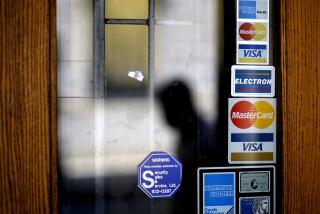Student-loan delinquencies may be higher than previously thought
Reporting from Washington — Some have called the nation’s soaring college debt load a “ticking bomb” -- a new bubble crisis threatening young adults, their families and the broader economy. Are those fears warranted?
A report Monday adds to the alarm bells. In it, the Federal Reserve Bank of New York says it’s likely that as many as one out of four borrowers are carrying a past-due student loan balance.
That’s a much higher rate of delinquency than previously thought. By the more conventional measure, the Fed report says, 5.4 million out of 37 million borrowers with student loan balances as of last summer had at least one past-due student loan account -- a 14.4% rate. The sum of those past-due balances comes to $85 billion, or about 10% of the total. The same 10% rate applies on average to other types of consumer delinquent debt, such as mortgages and credit cards.
But Fed researchers say those delinquency figures for student loans understate the magnitude of the problem. That’s because the calculations don’t take into account that federally guaranteed loans, which make up the bulk of the student debt, typically don’t require repayment while borrowers are still in school and also are deferred for six months upon graduation. If those who are temporarily exempt from making payments are excluded, the report shows, the number of borrowers with past-due balances jumps to 27% of the total. And the outstanding balances that are late rises to 21%. Both figures are about double the unadjusted rates.
The New York Fed report concludes that “student loan debt is not just a concern for the young. Parents and the federal government shoulder a substantial part of the post-secondary education bill.”
As for private, non-guaranteed student loans, Moody’s Investors Service reported recently that the default rate in the fourth quarter was 5.1%, about the same as a year earlier. Still, that rate is about double what it was before the 2007-2009 recession. Moreover, the Moody’s report noted that some private student loan measures indicate the pace of defaults is rising and that the problem isn’t likely to get better anytime soon.
“High unemployment will keep defaults high,” Moody’s said.
Experts have differing opinions about the strain of student loans to the broader economy. But there’s reason to be concerned. When asked about such risks by a lawmaker last week, Fed Chairman Ben Bernanke replied, “Well, student loans are becoming a very large category of loans.”
Indeed, the New York Fed put the latest outstanding student loan balance at $870 billion. That’s more than the total credit card debt ($693 billion) and what people owe in car loans ($730 billion).
Of course, what’s different about student lending from other consumer loans is that most of it is being done by the U.S. government. Even so, as Bernanke noted, if federal lending isn’t well managed, it could hurt taxpayers. “So I think it does require some careful oversight,” he said.
Bernanke, in his exchange with lawmakers, added a personal dimension to the student loan issue, saying that his son in medical school was expecting to owe $400,000 when he graduates.
Already, about 167,000 people, or about one-half of one percent of all student-loan borrowers, owe more than $200,000, the New York Fed said in its report, which drew from Equifax credit data. The average balance per borrower: $23,300.
More to Read
Inside the business of entertainment
The Wide Shot brings you news, analysis and insights on everything from streaming wars to production — and what it all means for the future.
You may occasionally receive promotional content from the Los Angeles Times.











